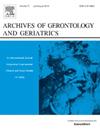Effects of dual-task prioritization training on dual-task walking in older people: A single-blinded randomized controlled trial
IF 3.8
3区 医学
Q2 GERIATRICS & GERONTOLOGY
引用次数: 0
Abstract
Objective
Dual-task walking (DTW) performance is commonly reduced in older adults and is associated with a higher risk of falls. While dual-task deficits have been documented, it remains unclear how different task prioritization strategies during training influence DTW outcomes. This study compared effects of posture-first (PF), supraposture-first (SF), and conventional training on DTW performance in older adults.
Methods
A three-arm randomized, single-blind controlled study was conducted. Thirty-nine community-dwelling older adults were randomly assigned to PF, SF, or control groups to receive 12-session of cognitive-motor dual-task training with distinct task prioritization instructions. Cognitive and motor DTW performance, Trail Making Test Part B, Berg Balance Scale, single-task walking performance, and secondary task performance were assessed pre- and post-intervention.
Results
The PF group showed significant improvements in both cognitive and motor DTW performance, including speed (cognitive: p = 0.001, motor: p = 0.008), cadence (p < 0.001), and dual-task cost (DTC-speed) (p < 0.001). Compared to the SF and control groups, the PF group showed greater improvements in stride length (p = 0.009 vs. SF; p = 0.001 vs. control) and DTC (p = 0.025 vs. SF; p = 0.005 vs. control) during cognitive DTW. During motor DTW, improvements in speed (p = 0.008), cadence (p = 0.016), and DTC (p = 0.049) were also greater than in the SF group.
Conclusions
Posture-first strategy during training enhances cognitive and motor DTW performance more effectively than other approaches. These findings support its implementation to improve functional mobility and dual-task coordination in older adults.
双任务优先级训练对老年人双任务行走的影响:一项单盲随机对照试验
目的:老年人双任务行走(DTW)的表现通常会下降,并且与摔倒的风险增加有关。虽然双任务缺陷已被记录在案,但尚不清楚训练期间不同的任务优先级策略如何影响DTW结果。本研究比较了姿势优先(PF)、上姿势优先(SF)和常规训练对老年人DTW表现的影响。方法采用三组随机、单盲对照研究。39名居住在社区的老年人被随机分配到PF组、SF组或对照组,接受12次认知-运动双任务训练,并根据不同的任务优先级指示进行训练。评估干预前后的认知和运动DTW表现、造径测试B部分、Berg平衡量表、单任务步行表现和次要任务表现。结果PF组在认知和运动DTW表现上均有显著改善,包括速度(认知:p = 0.001,运动:p = 0.008)、节奏(p < 0.001)和双任务成本(DTC-speed) (p < 0.001)。与SF组和对照组相比,PF组在认知DTW期间步幅(p = 0.009 vs SF; p = 0.001 vs对照组)和DTC (p = 0.025 vs SF; p = 0.005 vs对照组)有更大的改善。在运动DTW期间,速度(p = 0.008),节奏(p = 0.016)和DTC (p = 0.049)的改善也大于SF组。结论在训练过程中,姿势优先策略比其他方法更能提高认知和运动能力。这些发现支持其实施,以改善老年人的功能流动性和双任务协调。
本文章由计算机程序翻译,如有差异,请以英文原文为准。
求助全文
约1分钟内获得全文
求助全文
来源期刊
CiteScore
7.30
自引率
5.00%
发文量
198
审稿时长
16 days
期刊介绍:
Archives of Gerontology and Geriatrics provides a medium for the publication of papers from the fields of experimental gerontology and clinical and social geriatrics. The principal aim of the journal is to facilitate the exchange of information between specialists in these three fields of gerontological research. Experimental papers dealing with the basic mechanisms of aging at molecular, cellular, tissue or organ levels will be published.
Clinical papers will be accepted if they provide sufficiently new information or are of fundamental importance for the knowledge of human aging. Purely descriptive clinical papers will be accepted only if the results permit further interpretation. Papers dealing with anti-aging pharmacological preparations in humans are welcome. Papers on the social aspects of geriatrics will be accepted if they are of general interest regarding the epidemiology of aging and the efficiency and working methods of the social organizations for the health care of the elderly.

 求助内容:
求助内容: 应助结果提醒方式:
应助结果提醒方式:


